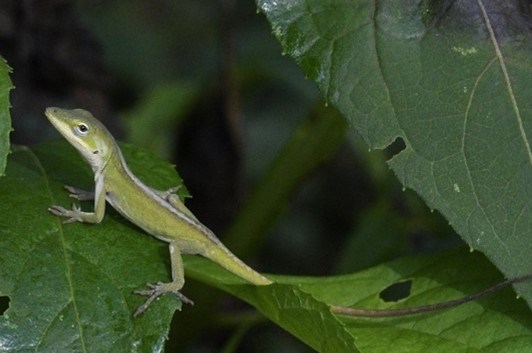
National Park Service Green AnoleThe green anole is a small to medium-sized lizard, with a slender body. The head is long and pointed with ridges between the eyes and nostrils, and smaller ones on the top of the head. The toes have adhesive pads to facilitate climbing. Color varies from brown to green and can be changed like many other kinds of lizards, but anoles are closely related to iguanas and are not true chameleons.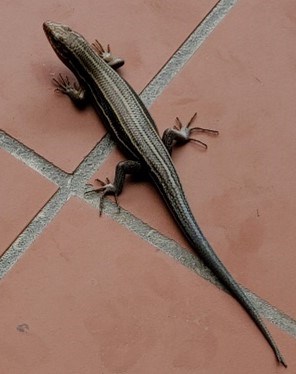
HOSP photo N. Allen American Five-lined SkinkThe American five-lined skink is small to medium-sized, growing to about 12.5 to 21.5 centimeters (4.9 to 8.5 in) total length (including tail). Young American five-lined skinks are dark brown to black with five distinctive white to yellowish stripes running along the body and a bright blue tail. The blue color fades to light blue with age, and the stripes also may slowly disappear. Females, however, are more likely to retain the blue tail color as they age.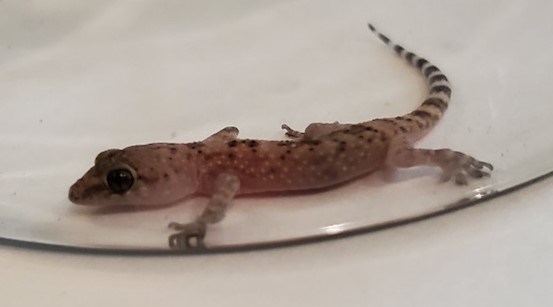
HOSP photo N.Allen Mediterranean GeckoThe Mediterranean Gecko is a very small lizard generally measuring between 10–13 cm (4–5 inches) in length with rounded snout, sticky toe pads, vertical pupils, and large eyes that lack eyelids. Light brown or grayish color, with dark spots and white tubercles, lower surfaces white. They may be completely translucent except for the spotting. Some are darker.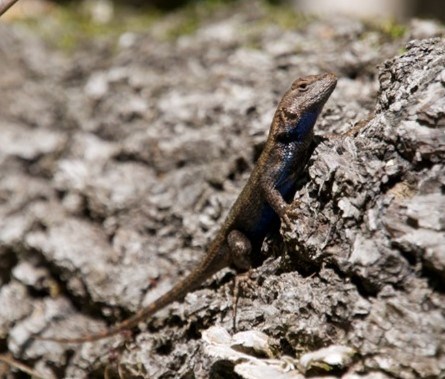
HOSP photo: Mitch Smith Prairie LizardThe adult Prairie Lizard ranges from 4–7 inches (10–18 cm) in total length. The tail is over half of the total length of individuals. The background color is light brown or light gray, and individuals have a wide gray middorsal stripe. A pale cream or white dorsolateral stripe runs from the neck to the base of the tail and is typically bordered by a rust-colored stripe with variable black or white markings. Sides are reddish-brown. Scales are large, keeled, and overlapping, giving it a rough, spiny appearance and texture.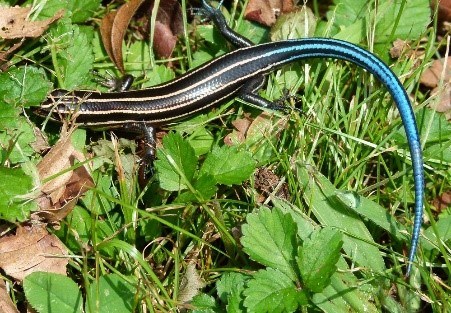
National Park Service Shinning-skinkThe Shinning Skink or blue-tailed skink typically grows to be 4-5cm in length. It can be identified by its small black body with two yellow strips running vertically down the skink's back and into its vibrant blue tail. The skink can use its blue tail to draw a predator’s attention away from its body by separating its tail from its body. The bright color of the skink's tail means predators are much more likely to notice the tail than the skink's black body.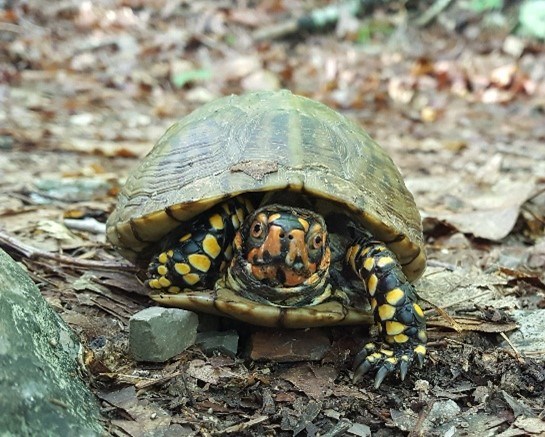
HOSP photo Three-toed Box TurtleThree-toed box turtles are so named due to the number of toes on the back feet, but there are some that have four. Three-toed box turtles have a domed shell which grows to 5-7″ (13-18cm) in length. The highest part of its carapace or upper shell is more posteriorly positioned than in any of the other subspecies. The dorsal and limb coloration is commonly completely absent, although some dark blotches are common in adult turtles. These areas more often being a uniform olive green or tan color. Sometimes, faint yellow dots or lines are visible in the center of each large scute. In the males, the head and throat often display yellow, red, or orange spots. Frequently, the bottom shell or plastron is a yellow straw color and has far fewer dark markings than the plastrons of the other subspecies. 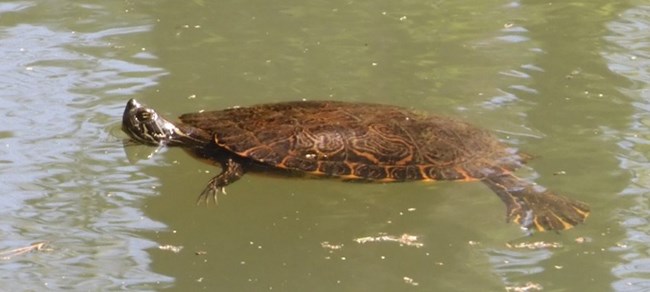
HOSP photo N.Allen Northern Map TurtleThe northern map turtle gets both its common and scientific names from the markings on its carapace, which resemble contour lines on a map or chart. These lines are usually shades of yellow, tan, or orange, and are surrounded by dark borders, with the rest of the carapace being olive or greyish brown. However, the carapace markings tend to fade as the animal matures, and in older individuals are usually only visible when the shell is wet. The carapace has a hydrodynamic appearance and is broad with a moderately low keel. The rear of the carapace is flared, and the rear marginals form serrations. The head, neck, limbs, and tail are dark green with thin yellow stripes, and an oval or triangular spot is located behind each eye.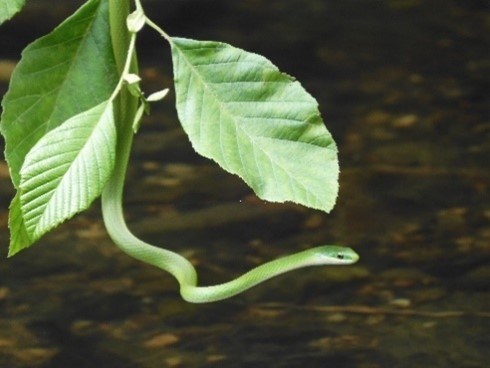
HOSP photo N.Allen Northern Rough Green SnakeThe northern rough green snake is a long and slender, nonvenomous snake. It is light green above and has a white or yellowish belly. Scales on the back have small ridges or keels, making it feel rough to the touch. This species is active by day and lives in bushes, vines, and low-hanging branches of trees near streams or lakes. It is often overlooked because it blends so well with its leafy surroundings. Green snakes are seen April through October, when they are most active. They are spotted as they crossroads, trails, and creeks. The beautiful green color helps these mild-mannered insectivores blend in with the trees where they live. specimens turn bluish.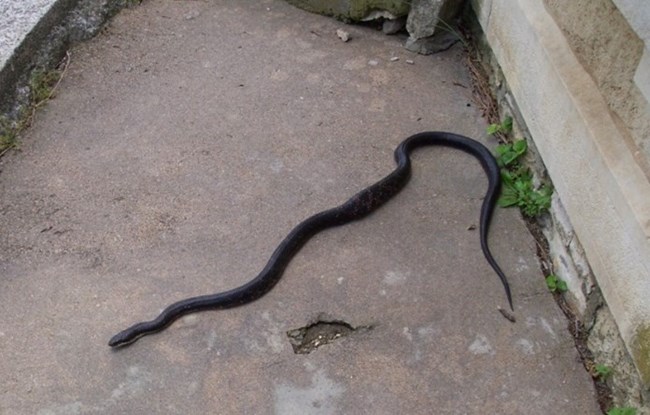
National Park Service Western Rat SnakeRat snakes are medium-to-large, nonvenomous snakes that kill by constriction. They pose no threat to humans, and as their name implies, rats are one of their favorite foods. They vary in color, but most are black, gray, or tan. Some species are also yellow, orange, reddish, cream, or any combination of the above. The various species also range from blotched and striped patterns to one solid color. Though they are not venomous, many species of them do their best to imitate venomous snakes. When cornered, these snakes will shake their tail rapidly to rattle nearby leaves and bushes.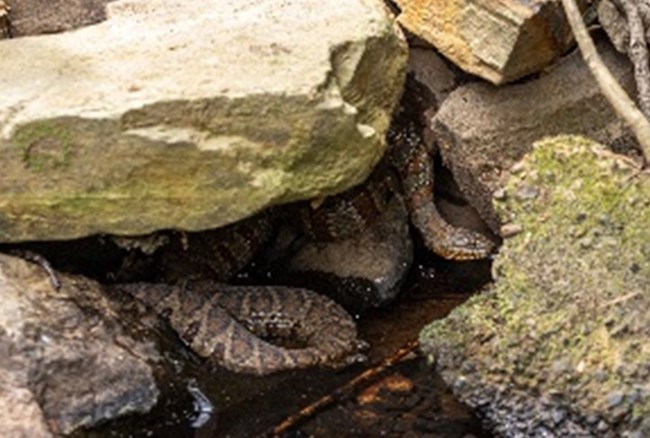
HOSP photo Midland Water SnakeThe Midland Water Snake is a non-venomous snake. It lives in or near any aquatic habitat: ponds, lakes, sloughs, streams, rivers, and marshes. Like most water snakes, it is sometimes mistaken for the venomous Cottonmouth but is thinner and has round eye pupils. It’s body is tan to brown; back and sides are marked with square, brown-black blotches in an alternating, checkerboard-like pattern, with blotches toward the head often fused into bands. Belly is marked with a double row of thin, half-moon shapes. Scales have obvious lengthwise ridges (keels). This snake gives birth to live young (does not lay eggs).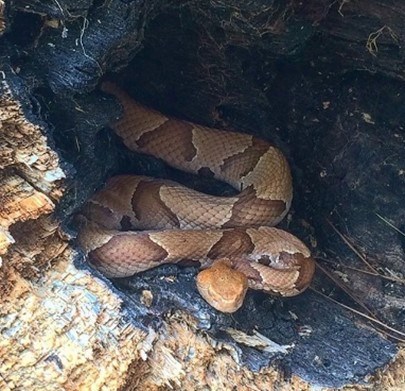
HOSP photo Copperhead (Venomous)The eastern copperhead has distinctive, dark brown, hourglass-shaped markings, overlaid on a light reddish brown or brown/gray background. The body type is heavy, rather than slender. Neonates are born with green or yellow tail tips, which progress to a darker brown or black within one year. Adults grow to a typical length (including tail) of 50–95 cm (20–37 in). It favors deciduous forest and mixed woodlands. It may occupy rock outcroppings and ledges, but is also found in low-lying, swampy regions. During the winter, it hibernates in dens or limestone crevices, often together with timber rattlesnakes and black rat snakes. Like most pit vipers, the eastern copperhead is generally an ambush predator; it takes up a promising position and waits for suitable prey to arrive.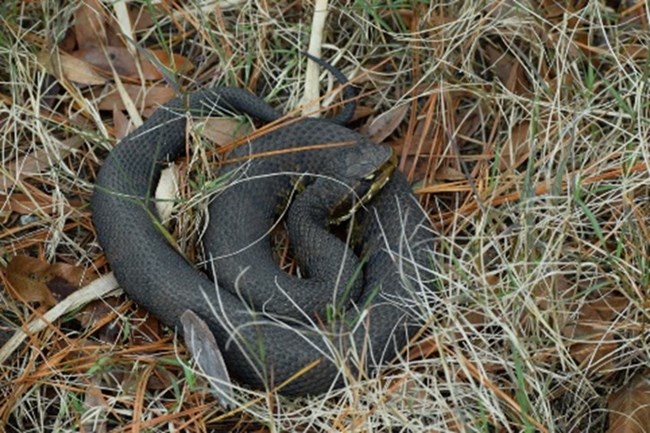
HOSP photo Water Moccasin/Cottonmouth (Venomous)The Water moccasin is a venomous snake, a species of pit viper native to the southeastern United States. As an adult, it is large and capable of delivering a painful and potentially fatal bite. Water moccasins are almost or even totally black, (except for the head and facial markings), the color pattern may consist of a brown, gray, tan, yellowish-olive, or blackish ground color, which is overlaid with a series of 10-17 dark brown to almost black crossbands. The underside of the head is generally whitish, cream, or tan. These snakes are usually associated with bodies of water, such as creeks, streams, marshes, swamps, and the shores of ponds and lakes.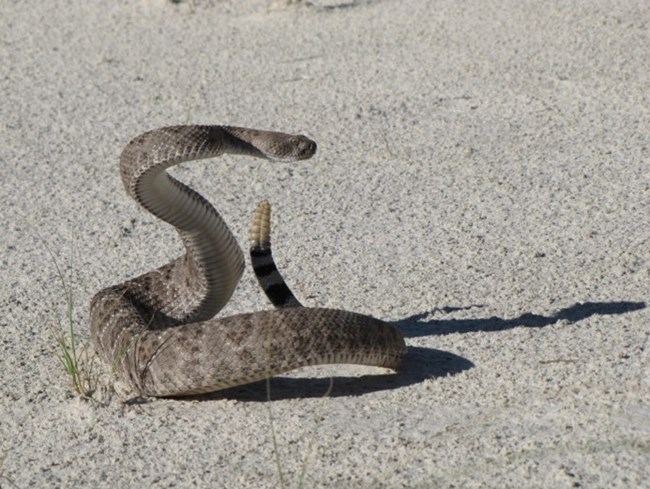
National Park Service NOT COMMOM BUT NEED TO KNOWDiamond Back Rattlesnake (Venomous)The diamondback rattlesnake is North America's longest, heaviest venomous snake, averaging 3-6 feet long, with some adults growing up to 8 feet. It's known for its iconic rattle and its venomous bite, which can be fatal to humans. The diamondback rattlesnake can be blackish-gray, olive green or muddy gray. Its tail is typically a different shade than its body, ranging from brown to gray and banded with dark rings. This species is easily identified by the diamond-shaped pattern along its back (the source of its common name), as well as the distinctive black band that covers its eyes, outlined by two pale lines. It has vertical, cat-like pupils, and there is a large pit between the nostril and the eye on each side of its face.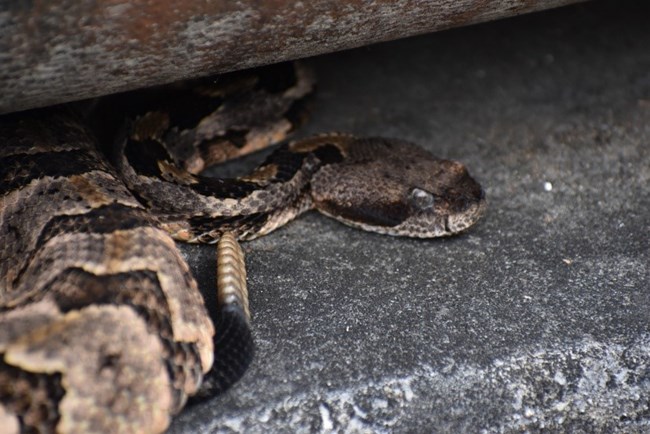
National Park Sevice Timber Rattlesnake (Venomous)The timber rattlesnake — also called the American viper, black rattlesnake, eastern rattlesnake, timber rattler and canebrake — is a large pit viper with a wide distribution across the eastern half of the U.S. These large, heavy pit vipers vary in coloration. They are gray, sometimes with a pinkish hue and have a stripe down their back. This stripe is orange, yellow or pinkish in some timber rattlesnakes, while others have a brown or black stripe. Both morphs, or variations in color, have darker or black coloration at the tip of their tail and dark stripes that form a chevron pattern along the back and sides of the snake. This distinct pattern and coloration help the timber rattlesnake camouflage among the vegetation on the ground. In some parts of their range, timber rattlesnakes are solitary and will hibernate alone in a stump hole or under ground cover. In other parts of their range, they congregate in dens underneath rocks, fissures in rocky ledges or other crevices. Often these dens are shared with other snake species too, both venomous and nonvenomous.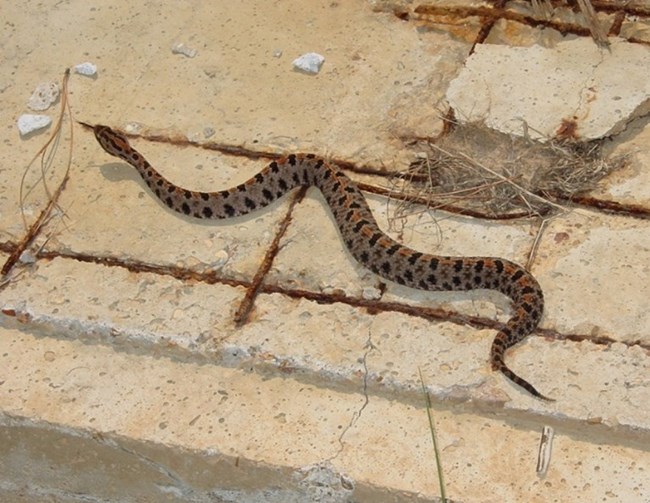
Pygmy Rattlesnake (Venomous)The Pygmy Rattlesnake is the smallest, and one of the least known, venomous snakes. A small, colorful rattlesnake (15.0 to 20.0 inches in length) with vertical pupil, thin tail, and tiny rattle. The body color is gray or tan with an orangish-brown mid-dorsal stripe usually present. There are dark blotches, typically bar-shaped, running along the length of the back with one or two rows of dark spots along each side of the body. The head has a wide, black stripe which starts at the eye and slopes down to the corner of the mouth; crown of head also has 9 large plates. Belly is dusky cream-color mottled with dark bars. Scales are keeled. Young have yellow-tipped tails. Found in a variety of habitats, but is usually in close proximity to water. Occurs in flood plains, wetlands, and moist fields; occasionally found in rocky uplands, pine woods, and glades. |
Last updated: October 6, 2022
